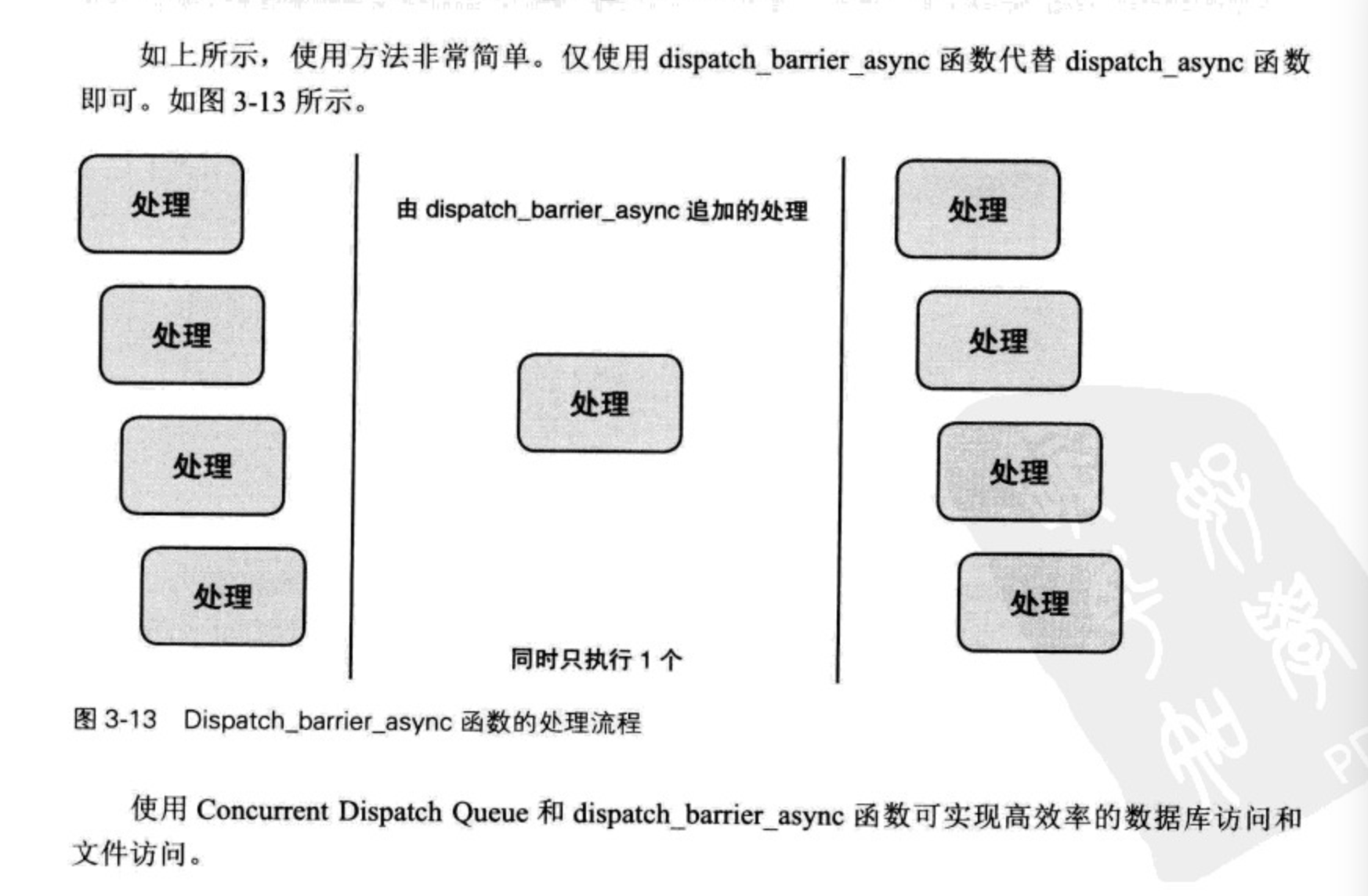iOS多线程编程
dispatch_async(queue, ^{ NSLog(@"想执行的任务"; });
编程人员在Block语法中记述想执行的处理并将其追加到Dispatch Queue中。Dispatch Queue按照追加顺序(先进先出 FIFO,First-In-First-Out)执行处理。

// 自定义串行队列,将任务ABC加到串行队列中,顺序执行 dispatch_queue_t customSerialQueue = dispatch_queue_create("test.wangdachui.MyCustomQueue", DISPATCH_QUEUE_SERIAL); dispatch_async(customSerialQueue, ^{ NSLog(@"customSerialQueue-A"); }); dispatch_async(customSerialQueue, ^{ NSLog(@"customSerialQueue-B"); }); dispatch_async(customSerialQueue, ^{ NSLog(@"customSerialQueue-C"); }); // 由于上面是异步执行操作,所以很难知道下面的打印和上面异步操作中的打印谁先谁后 NSLog(@"customSerialQueue-D"); //多个串行队列并行执行,系统对于一个serialQueue就只生成并使用一个线程。如果生成2000个serialQueue,那么就生成2000个线程 dispatch_queue_t customSerialQueue1 = dispatch_queue_create("test.wangdachui.MyCustomQueue", DISPATCH_QUEUE_SERIAL); dispatch_queue_t customSerialQueue2 = dispatch_queue_create("test.wangdachui.MyCustomQueue", DISPATCH_QUEUE_SERIAL); dispatch_queue_t customSerialQueue3 = dispatch_queue_create("test.wangdachui.MyCustomQueue", DISPATCH_QUEUE_SERIAL); dispatch_async(customSerialQueue1, ^{ NSLog(@"customSerialQueue1-A"); }); dispatch_async(customSerialQueue2, ^{ NSLog(@"customSerialQueue2-B"); }); dispatch_async(customSerialQueue3, ^{ NSLog(@"customSerialQueue3-C"); }); //注意:过多使用多线程,就会消耗大量内存问题,引起大量的上下文切换,大幅度降低系统的响应性能
并行队列(Concurrent Dispatch Queue):
iOS和OS X的核心--XNU内核决定应当使用的线程数,并只生成所需的线程执行处理。另外,当处理结束,应当执行的处理数减少时,XNU内核会结束不再需要的线程。XNU内核仅使用Concurrent Dispatch Queue便可以完美地管理并行执行多个处理的线程。
假设准备4个Concurrent Dispatch Queue 用线程。首先blk0在线程0中开始执行,接着blk1在线程1中、blk2在线程2中、blk3在线程3中开始执行。线程0中blk0执行结束后开始执行blk4,由于线程1中blk1的执行没有结束,因此线程2中blk2执行结束后开始执行blk5,就这样循环往复。
像这样在Concurrent Dispatch Queue中执行处理时,执行顺序会根据处理内容和系统状态发生改变。
为了说明线程分配原理,这里假设线程数为4,实测iOS11线程数可达20个,所以想测试的同学,在并发队列中必须追加20个以上的任务
对于Concurrent Dispatch Queue来说,不管生成多少,由于XNU内核只使用有效管理的线程,因此不会发生串行队列的那些问题(过多使用多线程,降低系统的响应性能)
// 自定义并行队列,将任务1234567加到串行队列中 dispatch_queue_t customConcurrentQueue = dispatch_queue_create("test.wangdachui.MyCustomQueue", DISPATCH_QUEUE_CONCURRENT); dispatch_async(customConcurrentQueue, ^{ NSLog(@"blk0"); NSLog(@"当前线程:%@",[NSThread currentThread]); }); dispatch_async(customConcurrentQueue, ^{ NSLog(@"blk1"); NSLog(@"当前线程:%@",[NSThread currentThread]); }); dispatch_async(customConcurrentQueue, ^{ NSLog(@"blk2"); NSLog(@"当前线程:%@",[NSThread currentThread]); }); dispatch_async(customConcurrentQueue, ^{ NSLog(@"blk3"); NSLog(@"当前线程:%@",[NSThread currentThread]); }); dispatch_async(customConcurrentQueue, ^{ NSLog(@"blk4"); NSLog(@"当前线程:%@",[NSThread currentThread]); }); dispatch_async(customConcurrentQueue, ^{ NSLog(@"blk5"); NSLog(@"当前线程:%@",[NSThread currentThread]); }); dispatch_async(customConcurrentQueue, ^{ NSLog(@"blk6"); NSLog(@"当前线程:%@",[NSThread currentThread]); });
2.2.2 Dispatch Group:在使用Concurrent Dispatch Queue或同时使用多个Dispatch Queue时,想要在Dispatch Queue中的处理全部结束后再执行其他处理。可以使用Dispatch Group。
dispatch_queue_t queue = dispatch_get_global_queue(DISPATCH_QUEUE_PRIORITY_DEFAULT, 0); dispatch_group_t group = dispatch_group_create(); // 把 queue 加入到 group dispatch_group_async(group, queue, ^{ // 一些异步操作任务 sleep(2); NSLog(@"任务GroupA\n当前线程:%@",[NSThread currentThread]); }); // code 你可以在这里写代码做一些不必等待 group 内任务的操作 NSLog(@"任务GroupB\n当前线程:%@",[NSThread currentThread]); // 当你在 group 的任务没有完成的情况下不能做更多的事时,阻塞当前线程等待 group 完工 dispatch_group_wait(group, DISPATCH_TIME_FOREVER); NSLog(@"任务GroupC\n当前线程:%@",[NSThread currentThread]); dispatch_group_notify(group, dispatch_get_main_queue(), ^(){ // 从主线程上执行 UI 界面更新 NSLog(@"任务GroupD\n当前线程:%@",[NSThread currentThread]); });
2.2.3 dispatch_barrier_async:
在访问数据库或文件时,为了高效地进行访问,读取处理追加到Concurrent Dispatch Queue中,写入处理在任一读取处理没有执行的状态下,追加到Serial Dispatch Queue中即可(在写入处理结束之前,读取处理不可执行)
dispatch_queue_t queue = dispatch_get_global_queue(DISPATCH_QUEUE_PRIORITY_DEFAULT, 0); dispatch_async(queue, ^{ NSLog(@"blk0_for_reading"); }); dispatch_async(queue, ^{ NSLog(@"blk1_for_reading"); }); dispatch_async(queue, ^{ NSLog(@"blk2_for_writing"); }); dispatch_async(queue, ^{ NSLog(@"blk3_for_reading"); }); dispatch_async(queue, ^{ NSLog(@"blk4_for_reading"); }); /*如上,如果简单地在dispatch_async函数中加入写入处理,那么根据Concurrent Dispatch Queue的性质,就有可能在追加到写入处理前面的处理中读取到与期待不符的数据,还可能因非法访问导致应用程序异常结束。因此我们要使用dispatch_barrier_async函数。dispatch_barrier_async函数会等待追加到Concurrent Dispatch Queue上的并行执行的处理全部结束之后,再将指定的处理追加到该Concurrent Dispatch Queue中。然后在由dispatch_barrier_async函数追加的处理执行完毕后,Concurrent Dispatch Queue才恢复为一般的动作,追加到该Concurrent Dispatch Queue的处理又开始执行。*/ dispatch_async(queue, ^{ NSLog(@"blk0_for_reading"); }); dispatch_async(queue, ^{ NSLog(@"blk1_for_reading"); }); dispatch_barrier_async(queue, ^{ NSLog(@"blk2_for_writing"); }); dispatch_async(queue, ^{ NSLog(@"blk3_for_reading"); }); dispatch_async(queue, ^{ NSLog(@"blk4_for_reading"); });
2.2.4 Dispatch Semaphore:信号量,关于信号量可以看我另外一篇帖子:iOS 信号量
// 创建信号量,并且设置值为10 dispatch_semaphore_t semaphore = dispatch_semaphore_create(10); dispatch_queue_t queue = dispatch_get_global_queue(DISPATCH_QUEUE_PRIORITY_DEFAULT, 0); for (int i = 0; i < 100; i++) { // 由于是异步执行的,所以每次循环Block里面的dispatch_semaphore_signal根本还没有执行就会执行dispatch_semaphore_wait,从而semaphore-1.当循环10次后,semaphore等于0,则会阻塞线程,直到执行了Block的dispatch_semaphore_signal 才会继续执行 dispatch_semaphore_wait(semaphore, DISPATCH_TIME_FOREVER); dispatch_async(queue, ^{ NSLog(@"信号量-index=%i",i); NSLog(@"信号量当前线程:%@",[NSThread currentThread]); sleep(2); // 每次发送信号则semaphore会+1, dispatch_semaphore_signal(semaphore); }); }
2.2.5 dispatch_apply:该函数按指定的次数将指定的Block追加到指定的Queue中,并等待全部处理执行结束
dispatch_queue_t queue = dispatch_get_global_queue(DISPATCH_QUEUE_PRIORITY_DEFAULT, 0); dispatch_apply(10, queue, ^(size_t index) { NSLog(@"%zu",index); }); NSLog(@"done"); /*打印结果 2017-09-20 10:49:29.760594+0800 Multithreading[11622:459025] 2 2017-09-20 10:49:29.760594+0800 Multithreading[11622:458947] 3 2017-09-20 10:49:29.760594+0800 Multithreading[11622:459027] 0 2017-09-20 10:49:29.760594+0800 Multithreading[11622:459026] 1 2017-09-20 10:49:29.760609+0800 Multithreading[11622:459077] 4 2017-09-20 10:49:29.760634+0800 Multithreading[11622:459078] 5 2017-09-20 10:49:29.760650+0800 Multithreading[11622:459079] 6 2017-09-20 10:49:29.760653+0800 Multithreading[11622:459080] 7 2017-09-20 10:49:29.760737+0800 Multithreading[11622:458947] 8 2017-09-20 10:49:29.760738+0800 Multithreading[11622:459025] 9 2017-09-20 10:49:29.761195+0800 Multithreading[11622:458947] done */
2.3 关于同步异步,串行并行的思考,看看打印结果,你就能悟真谛了。看的时候可以把测试代码拷贝到自己的项目中,自己思考一下,再回头看看打印结果。这样效果更好。大家不要嫌我写的烦,要好好听课。
//关于同步异步,串行,并行的思考 dispatch_queue_t mainQueue = dispatch_get_main_queue(); dispatch_queue_t globalQueue = dispatch_get_global_queue(DISPATCH_QUEUE_PRIORITY_DEFAULT, 0); dispatch_queue_t serialQueue = dispatch_queue_create("test.Lision.MyCustomQueue", DISPATCH_QUEUE_SERIAL); dispatch_queue_t concurrentQueue = dispatch_queue_create("test.Lision.MyCustomQueue", DISPATCH_QUEUE_CONCURRENT); [self dispatchAsyncWith:mainQueue]; /* 打印结果 2017-09-20 19:25:40.815678+0800 Multithreading[34153:2558588] 任务C 当前线程:<NSThread: 0x604000077440>{number = 1, name = main} 2017-09-20 19:25:42.843920+0800 Multithreading[34153:2558588] 任务A 当前线程:<NSThread: 0x604000077440>{number = 1, name = main} 2017-09-20 19:25:44.845176+0800 Multithreading[34153:2558588] 任务B 当前线程:<NSThread: 0x604000077440>{number = 1, name = main} */ //[self dispatchAsyncWith:globalQueue]; /* 打印结果:A/B的顺序随机 2017-09-20 19:28:26.395395+0800 Multithreading[34347:2580292] 任务C 当前线程:<NSThread: 0x60400006dc80>{number = 1, name = main} 2017-09-20 19:28:28.397384+0800 Multithreading[34347:2580443] 任务B 当前线程:<NSThread: 0x604000275ac0>{number = 3, name = (null)} 2017-09-20 19:28:28.397384+0800 Multithreading[34347:2580446] 任务A 当前线程:<NSThread: 0x60c00007c680>{number = 4, name = (null)} */ //[self dispatchAsyncWith:serialQueue]; /* 打印结果:串行队列生成一个新线程,AB顺序执行 2017-09-20 19:29:45.542392+0800 Multithreading[34394:2585219] 任务C 当前线程:<NSThread: 0x60000007f880>{number = 1, name = main} 2017-09-20 19:29:47.547666+0800 Multithreading[34394:2585681] 任务A 当前线程:<NSThread: 0x604000277540>{number = 3, name = (null)} 2017-09-20 19:29:49.550736+0800 Multithreading[34394:2585681] 任务B 当前线程:<NSThread: 0x604000277540>{number = 3, name = (null)} */ //[self dispatchAsyncWith:concurrentQueue]; /* 打印结果 A/B的顺序随机,AB并行执行,生成两个线程,最多生成几个线程由系统决定 2017-09-20 19:30:56.998360+0800 Multithreading[34446:2593417] 任务C 当前线程:<NSThread: 0x60400006ba40>{number = 1, name = main} 2017-09-20 19:30:59.001208+0800 Multithreading[34446:2593777] 任务B 当前线程:<NSThread: 0x608000275ac0>{number = 3, name = (null)} 2017-09-20 19:30:59.001206+0800 Multithreading[34446:2593775] 任务A 当前线程:<NSThread: 0x60400007ae40>{number = 4, name = (null)} */ //[self dispatchSyncWith:mainQueue];//死锁 /* 死锁原因:我们要在主线程同步执行任务A,但是同步执行任务A也算一个任务,我们称呼它为W。mainQueue是顺序执行的,当前正在执行的任务是W,W的内容是要执行A,所以把A加到mainQueue的尾部等待执行。A要执行,必须等W完成,W要完成,必须要执行A,相互等待,进入死锁。 所以,同步的时候,不能将任务添加到当前线程的串行Queue中 */ //[self dispatchSyncWith:globalQueue]; /* 打印结果 同步阻塞,顺序执行ABC 2017-09-20 19:59:25.961727+0800 Multithreading[34773:2655128] 任务A 当前线程:<NSThread: 0x60c000261bc0>{number = 1, name = main} 2017-09-20 19:59:27.962571+0800 Multithreading[34773:2655128] 任务B 当前线程:<NSThread: 0x60c000261bc0>{number = 1, name = main} 2017-09-20 19:59:27.962824+0800 Multithreading[34773:2655128] 任务C 当前线程:<NSThread: 0x60c000261bc0>{number = 1, name = main} */ // [self dispatchSyncWith:serialQueue]; /* 自己猜 */ // [self dispatchSyncWith:concurrentQueue]; /* 自己猜 */ } //异步调用各种Queue - (void)dispatchAsyncWith:(dispatch_queue_t)queue { dispatch_async(queue, ^{ sleep(2); NSLog(@"任务A\n当前线程:%@",[NSThread currentThread]); }); dispatch_async(queue, ^{ sleep(2); NSLog(@"任务B\n当前线程:%@",[NSThread currentThread]); }); NSLog(@"任务C\n当前线程:%@",[NSThread currentThread]); } //同步调用各种Queue - (void)dispatchSyncWith:(dispatch_queue_t)queue { dispatch_sync(queue, ^{ sleep(2); NSLog(@"任务A\n当前线程:%@",[NSThread currentThread]); }); dispatch_sync(queue, ^{ sleep(2); NSLog(@"任务B\n当前线程:%@",[NSThread currentThread]); }); NSLog(@"任务C\n当前线程:%@",[NSThread currentThread]); }
留了两个没有给结果,很简单的,经过上面的学习,结果是不是很简单。帖子准备了好几天,查阅了很多资料。关于使用NSOperation进行多线程编程,看我这篇帖子:iOS多线程--NSOperation



